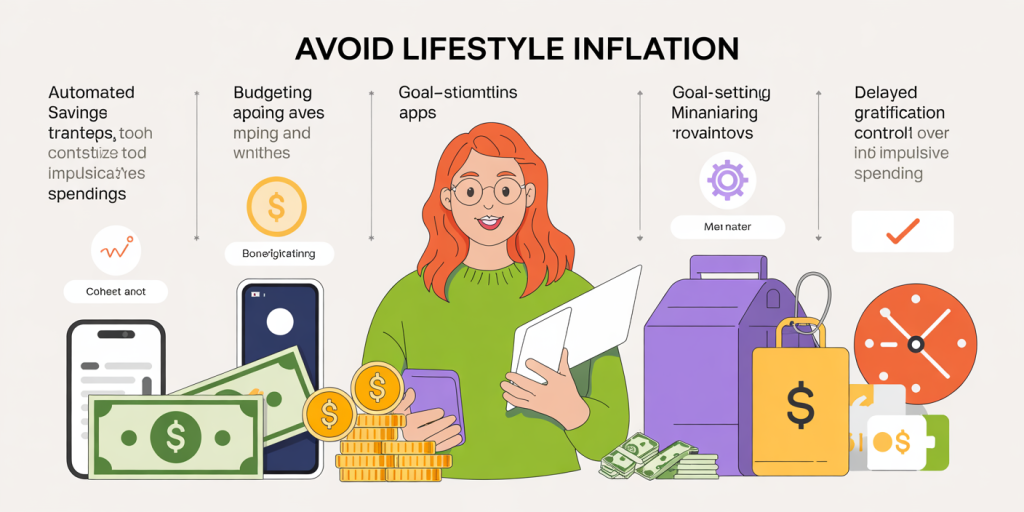How Lifestyle Inflation Silently Kills Your Wealth
In today’s fast-paced economic environment, many individuals feel the pressure to upgrade their lifestyles with every increment in income. While earning more money is commonly associated with financial freedom and wealth accumulation, an insidious trap known as lifestyle inflation often jeopardizes these goals. Lifestyle inflation, sometimes referred to as lifestyle creep, occurs when increased earnings lead to increased spending on non-essential items and luxuries, neutralizing the benefits of higher income. This phenomenon quietly erodes your financial stability and prevents the growth of long-term wealth.
Understanding the dynamics of lifestyle inflation is crucial, especially when reports show that nearly 75% of Americans live paycheck to paycheck despite steady income growth (PYMNTS, 2023). This trend poses serious risks to achieving financial independence and lasting wealth. To dive deeper, this article explores how lifestyle inflation operates, its real-world impacts, and actionable steps to safeguard one’s financial future.
What is Lifestyle Inflation and Why Does It Occur?
Lifestyle inflation happens when individuals increase their spending as their income rises, often spending most or all of their additional earnings instead of saving or investing them. This pattern is common after promotions, job changes with salary hikes, or other financial windfalls. Instead of growing one’s savings, individuals upgrade their houses, cars, clothing, dining habits, and vacations, creating a higher cost of living.

Psychologically, lifestyle inflation is fueled by social comparisons and the desire to “keep up with the Joneses.” For example, a study by the American Economic Association (2022) found that 62% of respondents admitted to upgrading their lifestyle mainly due to social pressure and expectations. The ease of earning more can often mask the fact that expenses are increasing proportionally, leaving no surplus for wealth-building.
Consider the example of Sarah, a marketing executive whose salary rose from $60,000 to $85,000 annually. Instead of saving the extra $25,000, she leased a new luxury vehicle, increased her dining-out budget, and moved into a more expensive apartment. By the end of the year, Sarah’s bank account balance barely changed despite her higher income. This is the silent killer side of lifestyle inflation: income grows, but net worth stagnates or even declines due to unchecked spending.
The Impact of Lifestyle Inflation on Wealth Accumulation
The core problem with lifestyle inflation is that it prevents wealth accumulation by consuming all additional income. When expenses rise at the same rate as income, or even faster, the capability to save or invest diminishes sharply. The true cost is not just in overspending but in the lost opportunity to harness compound growth on saved funds.
Let’s look at a hypothetical comparison over 10 years for two individuals: Alex and Jamie.
| Aspect | Alex (No Lifestyle Inflation) | Jamie (With Lifestyle Inflation) |
|---|---|---|
| Annual Income | $70,000 (increases 5% yearly) | $70,000 (increases 5% yearly) |
| Savings Rate | 20% of income | 5% of income |
| Annual Savings (Year 1) | $14,000 | $3,500 |
| Total Savings after 10 years (Assuming 7% return) | ~$200,000 | ~$50,000 |
This simplified table highlights how substantial savings and investments grow over time, whereas minimal saving due to lifestyle inflation limits long-term wealth. Even a modest increase in savings rate can generate a significant difference due to compounding interest.

Real-world data supports this: a 2021 Bankrate survey revealed that 39% of Americans have no emergency savings, and a majority report that higher earnings have been offset by higher costs or spending habits. Without conscious management, lifestyle inflation traps people in a cycle of living paycheck to paycheck, irrespective of salary increases.
Practical Examples of Lifestyle Inflation in Action
Lifestyle inflation manifests in many everyday scenarios. Take, for example, John and Emily, a couple in their 30s who both recently received promotions, combining for an annual household income increase of $40,000. They decided to rent a larger apartment, buy a new car, and increase discretionary expenses such as gourmet coffee and frequent vacations.
Before their raises, they saved 15% of their income and had roughly $30,000 in an emergency fund. Post-promotion, despite earning $40,000 more, their savings rate plummeted to just 5%, and emergency fund contributions ceased. Their monthly fixed expenses rose by 40%, and by the end of the year, their net savings were negligible. This cycle made them vulnerable to financial shocks, such as unexpected medical bills.
Another example is Jessica, who after a significant bonus, immediately upgraded her wardrobe and subscribed to several premium subscription services. While these choices improved her lifestyle momentarily, she missed the chance to invest that bonus into retirement accounts, potentially costing her thousands in future returns.
These cases underscore the necessity of deliberate financial planning with income changes, as impulsive lifestyle decisions have long-term consequences beyond mere budgeting challenges.

Strategies to Avoid Lifestyle Inflation
While lifestyle inflation is common and often subconscious, it can be mitigated with intentional strategies and awareness. Here are practical approaches to controlling it:
1. Automate Savings and Investments: Automatically directing a fixed percentage of every paycheck into savings or retirement accounts prevents the temptation to spend more with additional income. For example, increasing your 401(k) contributions with every raise can lock in future security.
2. Maintain a Budget and Track Expenses: Use budgeting apps or spreadsheets to track spending and compare fixed versus discretionary costs. This helps identify when lifestyle inflation begins to seep in. Regularly reviewing financial statements ensures you are aware of your spending patterns.
3. Prioritize Financial Goals Over Short-Term Pleasures: Define clear goals such as paying off debt, building an emergency fund, or saving for a house or retirement. When faced with spending choices, evaluate their alignment with these goals.
4. Delay Gratification: Instead of immediately upgrading lifestyle after income increases, adopt a “wait period” policy of 30-60 days before making major purchases. This reduces impulsive decisions based on new income.
5. Celebrate Non-Material Milestones: Seek fulfillment from experiences and achievements instead of material goods. Volunteering, learning skills, or physical fitness can provide satisfaction without inflating expenses.
Lifestyle Inflation’s Greater Economic Impact
Lifestyle inflation is not just a personal finance issue; it contributes to broader economic patterns that affect consumer behavior and financial markets. As consumer spending constitutes about 68% of the U.S. GDP (U.S. Bureau of Economic Analysis, 2023), the tendency for people to spend incrementally more with higher earnings drives demand for credit and influences inflation cycles.
Rising consumer debt is a key fallout of lifestyle inflation. According to Experian’s 2023 data, the average American consumer credit card balance reached $6,500, up 12% year-over-year, partially fueled by living beyond means. This debt accumulation diminishes creditworthiness and increases financial stress, reducing individual capacity for investment and economic resilience.
Additionally, lifestyle inflation may exacerbate wealth inequality. Those who understand how to control it and invest wisely can maximize their wealth growth, while others remain vulnerable to debt traps and limited asset accumulation, widening the economic divide.
Looking Ahead: Maintaining Wealth in the Age of Lifestyle Inflation
In the future, combating lifestyle inflation will require not only individual discipline but increased financial literacy and cultural shifts toward sustainable living. Technology and fintech innovations can help by simplifying savings, investments, and expense tracking. Furthermore, financial advisors emphasize the importance of mindset change—viewing income growth as an opportunity for wealth building rather than consumption.
Policy-level interventions such as incentivizing savings through tax benefits or financial education starting at school may also play a crucial role. By tackling lifestyle inflation collectively, societies can promote healthier economic habits and mitigate the hidden risks undermining wealth.
In the coming decades, as inflation pressures rise and job markets evolve, controlling lifestyle inflation will be essential for financial security. Adopting a balanced approach to income increases, reinforced by disciplined planning and technological tools, can safeguard wealth and foster long-term prosperity even in uncertain economic climates.
Lifestyle inflation may silently erode wealth if left unchecked but understanding its mechanisms and consequences empowers individuals to build financial resilience. By committing to measured spending aligned with goals, automating savings, and seeking fulfillment beyond material possessions, one can break free from this common financial trap. In doing so, it becomes possible not only to grow wealth but to enjoy greater peace of mind and genuine financial freedom.
